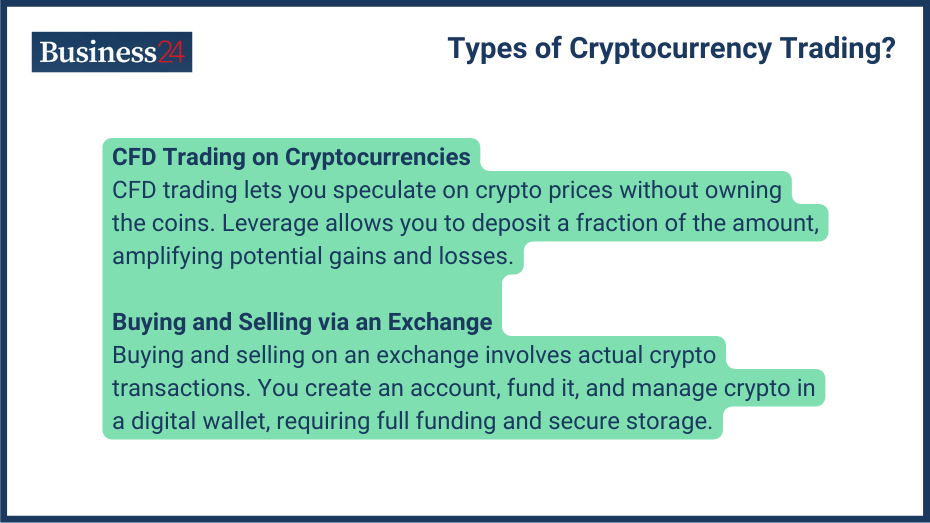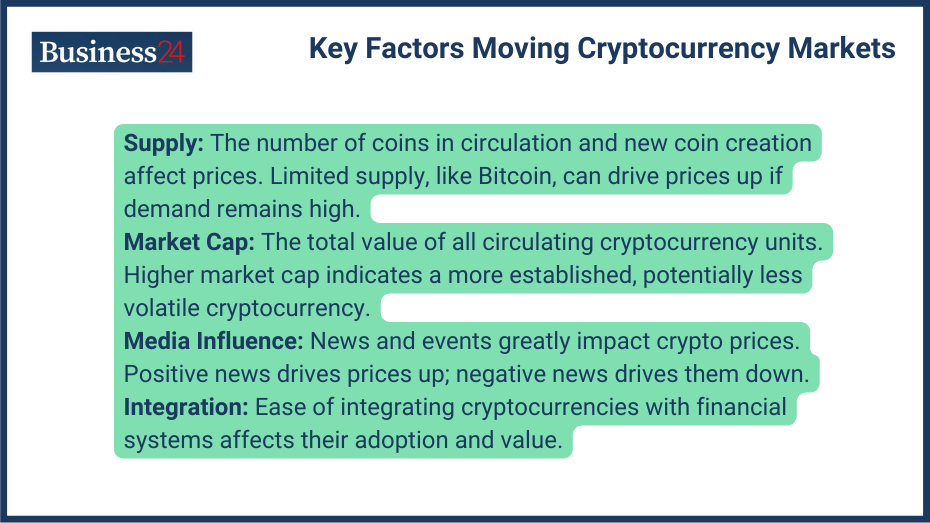
A cryptocurrency is a digital or virtual currency secured by cryptography, which makes it nearly impossible to counterfeit or double-spend.
Cryptocurrency is the new oil after the data; it is now the hottest thing in town. With the increased knowledge and resources, cryptocurrency trading has become famous and is one of the most traded assets.
Cryptocurrency trading involves speculating on the price movements of digital assets like Bitcoin, Ethereum, and others. Unlike buying and holding cryptocurrencies for the long term, cryptocurrency trading focuses on short-term price fluctuations to generate profits.
This can be done through a Contract for Difference (CFD) or the traditional method of buying and selling the coin. Traders can buy and sell according to their analysis, enabling potential profits from rising and falling market conditions. So, you can benefit from both sides of price movement.
What are the Types of Cryptocurrency Trading?

CFD Trading on Cryptocurrencies
CFD trading on cryptocurrencies allows traders to speculate on price changes without owning the actual crypto. It is a leveraged product, meaning you only have to deposit a fraction of the amount needed to buy the coin. This leverage magnifies potential profits and losses; a trader must understand that this is a double-edged sword.
Buying and Selling via an Exchange
Buying and selling via an exchange involves an actual crypto transaction, like the traditional one done with other assets. Traders have to create an account on an exchange, fund it, and manage the crypto in a digital wallet. This method requires full funding of the purchase and secure storage of tokens until they are sold.
How Do Cryptocurrency Markets Work?
Crypto was introduced in 2009, so much research and study materials have been available. Cryptocurrency can be complex, but understanding key concepts can show how it functions. Here’s a breakdown of three fundamental aspects:
Decentralized Nature: This is the main fundamental concept that made cryptocurrencies stand out. The idea was that no one would control the system. Crypto markets operate across a network of computers without central authority backing. Traditional financial systems rely on intermediaries like banks or brokers to facilitate transactions. Meanwhile, crypto transactions happen directly between users on a peer-to-peer network.
Blockchain Technology: Blockchain is a public ledger that continuously grows records of all cryptocurrency transactions. It works as a bookkeeper for the network. Each transaction is verified and cryptographically linked to the previous one, creating a difficult-to-tamper-with chain of blocks.
Mining: It is the process of validating transactions and adding them to the blockchain, generating new crypto units. Miners are special computers that solve complex mathematical puzzles to validate transactions. They are compensated with newly created cryptocurrency units as a reward for their work.
Is trading crypto a good idea?
It depends on the individual; an experienced trader can easily adapt and make good, while a novice can face many problems due to the higher volatility of the crypto market. Trading crypto can be a good idea if you understand and can manage its high volatility and the risks associated with an unregulated market. As said, the potential for high returns exists if you have good experience and understanding. At the same time, for a new trader, the extreme price swings and lack of regulation can be a recipe for disaster, especially for beginners.
So, there is no one-size-fits-all answer to this question; it depends on the individual’s experience and knowledge and the risks and cautions he is willing to take.
Key Factors Moving Cryptocurrency Markets

Several factors can influence cryptocurrency markets:
- Supply: Like all the financial assets in cryptos, supply and demand works the same. The total number of coins in circulation (supply) and the rate at which new ones are created (through mining for some currencies) play a crucial role. Limited supply, like with Bitcoin, can drive prices up if demand remains high.
- Market Capitalization: The total value of all circulating cryptocurrency units for a specific coin. A higher market cap indicates a more established cryptocurrency, potentially with lower volatility.
- Media Influence and Key Events: As there are no earnings or other financial aspects like stocks, the crypto market is heavily influenced by news, developments, and economic factors. Positive news about adoption, technological advancements, or major partnerships attracts buyers and increases the coin’s price. Conversely, negative news like security breaches, hacks, or regulatory crackdowns can bring the price crashing down.
- Integration: The ease of integrating cryptocurrencies with existing financial systems impacts their adoption and value.
Is crypto trading safe?
In my opinion, as compared to other assets, crypto carries more volatility, so more risk. However, whether trading crypto is safe depends on one’s experience and capabilities. Crypto trading carries risks due to its high volatility and the lack of centralized regulatory oversight. High-risk and high-reward work in the crypto market, and while it can give huge returns, losses can be big in size, too.
Trading crypto can be safe for those familiar with the risks and with strategies to mitigate them. Due to market volatility, it offers high potential returns but requires a thorough understanding of the market dynamics and the ability to manage investment risk.
What are the Benefits and Risks of Cryptocurrency Trading?
Benefits:
1. High Volatility
One of the main attractions of the crypto market has been the huge price swings. While this volatility is risky, it also presents the opportunity for substantial profits. If you can accurately predict price movements and make smart trades, you can generate good profits, too.
2. Diversification
There has been a lot of debate on diversification in history, whether it is good or not it provides an option for investors. Crypto offers a new and unique asset class that can be used to diversify your investment portfolio. You can spread your risk if you want, so your portfolio won’t be impacted by any specific asset class.
3. 24/7 Market
Unlike traditional stock markets with specific operating hours, cryptocurrency markets operate around the clock, 365 days a year. This global accessibility allows you to trade cryptos whenever convenient, providing greater flexibility and potentially more trading opportunities than markets with limited hours.
Risks:
Market Volatility:
As traders can benefit from the high volatility, it can also result in huge losses. So, it is a double-edged sword, and you need proper knowledge and experience.
2. Regulatory Risks
The regulatory landscape surrounding cryptocurrencies is constantly evolving; it has not been accepted worldwide. Governments worldwide are still grappling with classifying and regulating these digital assets, and regulation changes can dramatically impact the market.
3. Security Risks
Cryptocurrencies exist in the digital world, making them vulnerable to hacking cyberattacks and other risks like fraud. Unlike traditional banks with high-security measures, crypto exchanges and digital wallets can be targeted for theft.
A security breach at an exchange could lead to losing your crypto holdings. Even if you store your crypto offline in a digital wallet, you must be cautious about cybersecurity practices to protect your private keys. One wrong click on a malicious link or a weak password could result in your crypto vanishing without a trace.
Practical Applications and Strategies in Cryptocurrency Trading
- Day Trading: Buying and selling on the same day, day trading is a fast-paced strategy for income generation. A short-term strategy uses technical analysis for frequent buying/selling to capitalize on price movements (high risk).
- Holding: Based on its fundamental and symbolic significance, cryptocurrency can be chosen as a long-term investment. This type of investment focuses on underlying tech and future potential, and it holds crypto regardless of short-term volatility (lower risk).
- Arbitrage: Using the price differences between exchanges for quick profits by buying low and selling high on different platforms (requires speed and exchange knowledge).
Educational Resources and Tools
- Books and Articles: As I have mentioned earlier, there have been many research studies conducted on cryptocurrency. These resources explore various ways to understand the functioning of the crypto market.
- Online Courses: If you prefer a structured learning environment, online courses offer tutorials and in-depth content. Not all the courses are worth it, but some courses can help you learn the basics of the crypto market.
- Financial Tools: You shouldn’t bet big if you don’t understand. Before risking real capital, trading simulators and calculators allow you to experiment with different strategies and test your skills in a simulated environment. These tools can help you refine your approach and plan trades more effectively.
Can you make $100 a day with crypto?
Earning $100 daily through crypto trading sounds appealing, but it’s quite challenging to achieve consistently. It is the same with any other asset class, and while it is very easy for an experienced trader to achieve this, a novice can lose all the capital trying to.
Crypto markets are highly volatile, so even good trades can quickly go wrong. Before thinking like this, you need to develop skills in trading strategies, risk management, and market analysis, which all come with experience. While having a larger starting capital can boost your potential earnings, making $100 daily is still a stretch with smaller investments.
So, is it possible? This may be for experienced traders with a well-defined strategy and an understanding of the risks involved. But for beginners, aiming for consistent daily profits is unrealistic. It’s wiser to focus on learning the ropes, practicing with a simulator, and starting small.
Disclaimer
eToro is a multi-asset platform which offers both investing in stocks and cryptoassets, as well as trading CFDs.
Please note that CFDs are complex instruments and come with a high risk of losing money rapidly due to leverage. 51% of retail investor accounts lose money when trading CFDs with this provider. You should consider whether you understand how CFDs work, and whether you can afford to take the high risk of losing your money
This communication is intended for information and educational purposes only and should not be considered investment advice or investment recommendation. Past performance is not an indication of future results.
Copy Trading does not amount to investment advice. The value of your investments may go up or down. Your capital is at risk.
Don’t invest unless you’re prepared to lose all the money you invest. This is a high-risk investment and you should not expect to be protected if something goes wrong. Take 2 mins to learn more
eToro USA LLC does not offer CFDs and makes no representation and assumes no liability as to the accuracy or completeness of the content of this publication, which has been prepared by our partner utilizing publicly available non-entity specific information about eToro.
